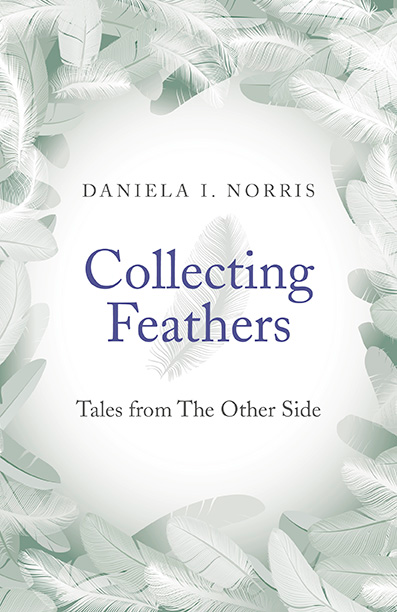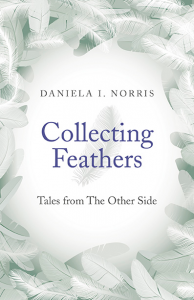Collecting Feathers: Tales from the Other Side by Daniela I. Norris
-Reviewed by Sarah Gonnet–
Despite the title, and repeated motifs of death and the other side; Collecting Feathers (Soul Rocks Books, November 2014) is actually a collection of tales more about the journey to get to the end point of crossing over, than death itself. Each of the short stories in this book are completely different from the last, and yet also curiously similar. This variation forms a powerful reflection of the book’s major theme: the vast range of human journeys through life.
By looking at characters that range from a psychotic teenager, to a woman who has lost her son, to a sci-fi scenario involving CERN allows Daniela Norris to explore a wide variety of human experiences. The lives that she looks at are fictional and at times surreal, but also read as if they could be authentic biographies. Almost like Shakespeare’s oeuvre, Norris makes an attempt to look at all aspects and areas of human life. Her characters spiral off in different directions, using the physicality of the book only as a rudimentary base of operations- just as real humans use the natural world.
However there are elements that tie the stories together. On their individual pathways a lot of the characters are obsessed with death and the afterlife, or are at least very aware of their mortality. Time is unclear throughout; both the era and sense of time passing within the story are ambiguous. This timelessness is a technique that allows people in Norris’ stories to represent a wider social group as well as themselves. It also allows the reader an extra opportunity to identify with the characters.
Yet at the same time the characters each have a type of fluid identity. They often discuss phases in their life, or how they became a completely different person due to a mood change or major life event. Shifts in identity like this, especially ones that happen before the plot timeline within the story, are very rare in literature. Perhaps this is due to suspension of belief leaving the reader vulnerable and therefore grasping for a solid character to guide them through the story. In most literature the protagonist does change, but always in response to events within the plot. Norris doesn’t allow her readers this safety net. The result is confusing and uncomfortable, but also fascinating. It is an observation on the randomness of life; something that writers are frequently terrified of.
Norris allows for the movement of internal and unconscious factors on identity, as well as external happenings. For example the depression and psychotic symptoms that the character Oliver in the first story experiences. This story is entirely seen through a lens of mental illness (something that dribbles through to frequently make an appearance in the other stories). In this story the major change is internal- the process of supposed recovery. Norris describes the process beautifully: ‘The dark shadows that lurked in my head when I first arrived now hid in my liver, in my kidneys, in my joints and under my skin. They hid where they could not be seen by others, but I knew they were there.’ This is also an example of Norris’ theme of identity division and fluidity- there are three phases clearly mentioned in the story, before illness, illness and life in a psychiatric facility and then the appearance of recovery.
Other links between the stories include symbolic motifs such as abandoned houses representing the empty shell of humanity. Norris’ characters are also mostly lonely, and several of them see imaginary friends, ghosts, or outright hallucinations to compensate for this. Yet despite common traits of mental illness, the characters Norris writes about are not usually outsiders of society. Instead they are mostly surprisingly ordinary, with jobs and families, yet still have plenty of capacity for mental anguish. As one in four people suffer from mental illness, this representation is more accurate than other writers approaches of describing eccentric traits alongside mental illness in their characters.
All of the stories are impositions on their character’s lives. This seems to sharpen Norris’ words and adds to the story’s fake realism. We enter the character’s lives at a point of questionable identity and leave each story at a dramatic moment that usually wouldn’t be deemed appropriate as an ending. As readers we are given no answers and no comforting finish. This mirrors the mysteries of real life perfectly.
Collecting Feathers: Tales from the Other Side is a woven text of people, places and tales that try to imitate real life; yet with a fresh viewpoint that changes slightly with each story. The result is a beautiful and varied piece of work. It is vital reading for any curious mind that wants to be taken to new and inventive places.






